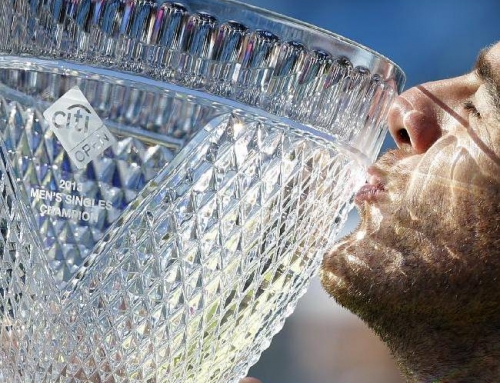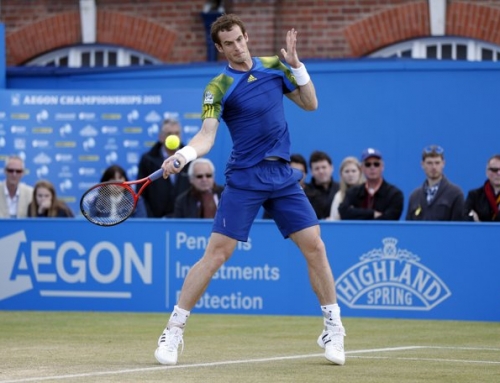 Easily, easily, the best Murray has played against Nadal in their meetings. This tops his brilliant performance over Nadal back in 2008 Open when the upstart 6th seed upset the second player in the world.
Easily, easily, the best Murray has played against Nadal in their meetings. This tops his brilliant performance over Nadal back in 2008 Open when the upstart 6th seed upset the second player in the world.
To give you some idea of how good Murray’s performance was, Murray has only ever taken a 6-0 set off Nadal and that was back in 2009 in Rotterdam and Nadal was injured in that match late in the first set. This time around, Nadal was fine, but only won 4 points in the entire final set.
It goes to show that Murray’s strategy to play Nadal in the US Open was still a work in progress. At the time, he wanted to overpower Nadal which is what he tried to do, but was unable because he made far too many errors.
Murray’s strategy then as now contrasts greatly with Djokovic. Djokovic is basically a counterpuncher, and Djokovic knows this all too well. Murray is, in essence a counterpuncher too, but whenever he plays Nadal, he amps the offense. He’s not interested in going toe-to-toe with Nadal. Anyone who watched the US Open knows that Djokovic was particularly willing to play long rallies, points that would last 20-30 shots and play a wearying style to beat Nadal. It works, but it comes at a price. It is particularly punishing to the body.
Even now, Djokovic has yet to recover from the injury sustained back in Cincy where his back was starting to bother him. Such is the price one pays to try and outlast Nadal.
When Djokovic was on his win streak, everyone said that Djokovic had the best backhand in the game. With this victory, Murray puts forward the claim that he has the best backhand in the game. What had hurt Murray up to this point was his reluctance to hit down-the-line. He used it to great effect back in his upset win in the 2008 US Open semi over Nadal, but that was then. In those days, Nadal struggled moving to his left. If you could strike a good inside-out forehand to Nadal’s forehand, he was likely to miss that shot, so much did the Spaniard favor his forehand and move to his backhand corner to get forehands. Since those years, Nadal has done far better at covering his wide forehand, and that has meant it’s tougher to attack Nadal’s forehand.
Murray’s strategy to play Nadal was inspired, I think, partly by Djokovic. Attack the Nadal backhand. Murray has improved his backhand so he can attack down the line. When he comes to net, he attacks with a less severe angle so Nadal can’t angle the passing shot and so Murray gets a chance to volley. Murray also has a standard crosscourt backhand. Then he has the very flat, hard hit crosscourt short angle. He was able to use this to good effect throughout the match. Nadal would either aim down the line and Murray would go crosscourt for the winner or he would go crosscourt and Murray would aim down the line for the good shot.
It didn’t look like it would be good news for Murray right away. Murray elected to serve, and he lost his serve right away. Although he began to hold serve more easily and had chances in Nadal’s game, Murray couldn’t break through and Nadal took the first set, 6-3.
In the second set, with Murray comfortably hitting tough shots, which includes a shot Federer would recognize–the inside out forehand for the winner, Murray found himself in a tight game at 2-1 with chances to break. After a long game, Murray secured the break to 3-1. But then Nadal got Murray down 0-40 with errors on Murray’s part. Murray powered in 3 aces to tie the game at deuce. Nadal managed to get an ad again, but Murray was able to keep winning points and then secure the hold at 4-1. Nadal would hold serve again, but Murray would hold and break once again.
And from then on, Murray was at the races. Feeling every shot, Murray was hitting returns for winners, and holding his own serve fairly easily. Nadal was beginning to struggle with the onslaught as Murray was feeling supremely confident. Nadal won only 4 points in the third set and Murray won that set at love.
This means Murray will pick up 500 points (actually a net of 410 points given the 90 pts he earned in Beijing last year). Given that Nadal had won their 5 previous meetings, this was no sure thing, but given how he manhandled Ferrer, there was an inkling that Murray was ready to give Nadal all he could handle. Was Nadal at his best? Hard to say. This was his first tournament back. But one thing that should make Murray happy is that Nadal wasn’t tired. Often Nadal’s game sinks a bit if he’s played a very long match. Murray should know. He pushed Nadal in last year’s year-end championship in a grueling semifinal win that may have helped Federer secure the win in the final.
Murray’s strategy has one positive. Djokovic’s method of beating Nadal is really punishing. Murray’s strategy certainly requires exquisite timing, but it’s far less taxing on Murray. Murray isn’t willing to play this style against everyone, probably because he is concerned about injuring himself. He can be less aggressive and still win matches and likely he’ll prefer to play lesser opponents in this fashion.
Murray now heads to Shanghai. The issue there will be the amount of work Murray has put in so far. He’s played two consecutive weeks and may become a bit fatigued in Shanghai. He may choose to take a few weeks off after Shanghai to rest up and just play Paris although he has historically played Valencia prior to Paris. With 750 points built up from Bangkok and Tokyo, he no longer needs to win Shanghai to have a reasonable hold on the #3 ranking, but if he can keep his stamina and make a good go, he’ll go a long way to reaching his goal.
And, for once, he’s built his game that might be able to handle the top 3. Whether he can play this good all the time remains to be seen, but for now, it’s a pretty amazing accomplishment.



![[Basel] del Potro wins Basel over Federer for second consecutive year](https://www.essentialtennis.com/wp-content/uploads/2013/10/20131028delpo-500x383.jpg)


